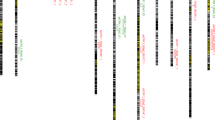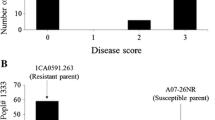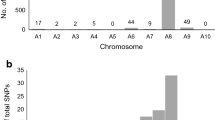Abstract
To date, mechanisms of partial quantitative resistance, under polygenic control, remain poorly understood, studies of the molecular basis of disease resistance have mainly focused on qualitative variation under oligogenic control. However, oligogenic conferred resistance is rapidly overcome by the pathogen and knowledge of the relationship between qualitative and quantitative resistance is necessary to develop durably resistant cultivars. In this study, we exploited the Arabidopsis thaliana-Plasmodiophora brassicae pathosystem to decipher the genetic architecture determining partial resistance. This soil-borne pathogen causes clubroot, one of the economically most important diseases of Brassica crops in the world. A quantitative trait locus (QTL) approach was carried out using two segregating populations (F2 and recombinant inbred lines) from crosses between the partially resistant accession Burren and the susceptible accession Columbia. Four additive QTLs (one moderate and three minor) controlling partial resistance to clubroot were identified, all the resistance alleles being derived from the partially resistant parent. In addition, four epistatic regions, which have no additive effect on resistance, were also found to be involved in partial resistance. An examination of candidate genes suggested that a potentially diverse array of mechanisms is related to the different QTLs. By fine-mapping and cloning these regions, the mechanisms involved in partial resistance will be identified.




Similar content being viewed by others
References
Alix K, Lariagon C, Delourme R, Manzanares-Dauleux MJ (2007) Exploiting natural genetic diversity and mutant resources of Arabidopsis thaliana to study the A. thaliana–Plasmodiophora brassicae interaction. Plant Breeding 126:218–221
Alonso-Blanco C, El-Assal SE, Coupland G, Koornneef M (1998) Analysis of natural allelic variation at flowering time loci in the Landsberg erecta and Cape Verde Islands ecotypes of Arabidopsis thaliana. Genetics 149:749–764
Arabidopsis Genome Initiative (2000) Analysis of the genome sequence of the flowering plant Arabidopsis thaliana. Nature 408:796–813
Arbeiter A, Fähling M, Graf H, Sacristán MD, Siemens J (2002) Resistance of Arabidopsis thaliana to the obligate biotrophic parasite Plasmodiophora brassicae. Plant Prot Sci 38:519–522
Bell CJ, Ecker JR (1994) Assignment of 30 microsatellite loci to the linkage map of Arabidopsis. Genomics 19:137–144
Bent AF, Kunkel BN, Dahlbeck D, Brown KL, Schmidt R, Giraudat J, Leung J, Staskawicz BJ (1994) Rps2 of Arabidopsis thaliana: a leucine-rich repeat class of plant disease resistance genes. Science 265:1856–1860
Boyes DC, Zayed AM, Ascenzi R, McCaskill AJ, Hoffman NE, Davis KR, Gorlach J (2001) Growth stage-based phenotypic analysis of Arabidopsis: a model for high throughput functional genomics in plants. Plant Cell 13:1499–1510
Brodmann D, Schuller A, Ludwig-Muller J, Aeschbacher RA, Wiemken A, Boller T, Wingler A (2002) Induction of trehalase in Arabidopsis plants infected with the trehalose-producing pathogen Plasmodiophora brassicae. Mol Plant Microbe Interact 15:693–700
Churchill GA, Doerge RW (1994) Empirical threshold values for quantitative trait mapping. Genetics 138:963–971
Denby KJ, Kumar P, Kliebenstein DJ (2004) Identification of Botrytis cinerea susceptibility loci in Arabidopsis thaliana. Plant J 38:473–486
Deslandes L, Olivier J, Peeters N, Feng D, Manirath K, Boucher C, Somssich I, Genin S, Marco Y (2003) Physical interaction between RRS1-R, a protein conferring resistance to bacterial wilt, and PopP2, a type III effector targeted to the plant nucleus. Proc Natl Acad Sci USA 100:8024–8029
Devos S, Laukens K, Deckers P, Straeten Dvd, Beeckman T, Inze D, Onckelen Hv, Witters E, Prinsen E (2006) A hormone and proteome approach to picturing the initial metabolic events during Plasmodiophora brassicae infection on Arabidopsis. Mol Plant Microbe Interact 19:1431–1443
Doyle J, Doyle J (1990) Isolation of plant DNA from fresh tissue. Focus 12:13–15
Fähling M, Graf H, Siemens J (2003) Pathotype separation of Plasmodiophora brassicae by the host plant. J Phytopathol 151:425–430
Flor HH (1971) Current status of the gene-for-gene concept. Annu Rev Phytopathol 9:275–296
Fuchs H, Sacristán MD (1996) Identification of a gene in Arabidopsis thaliana controlling resistance to clubroot (Plasmodiophora brassicae) and characterization of the resistance response. Mol Plant Microbe Interact 9:91–97
Gassmann W, Hinsch ME, Staskawicz BJ (1999) The Arabidopsis RPS4 bacterial-resistance gene is a member of the TIR-NBS-LRR family of disease-resistance genes. Plant J 20:265–277
Gebhardt C, Valkonen JPT (2001) Organization of genes controlling disease resistance in the potato genome. Annu Rev Phytopathol 39:79–102
Grsic S, Kirchheim B, Pieper K, Fritsch M, Hilgenberg W, Ludwig-Muller J (1999) Induction of auxin biosynthetic enzymes by jasmonic acid and in clubroot diseased Chinese cabbage plants. Physiol Plant 105:521–531
Hammond-Kosack KE, Parker JE (2003) Deciphering plant-pathogen communication: fresh perspectives for molecular resistance breeding. Curr Opin Biotechnol 14:177–193
Hirai M (2006) Genetic analysis of clubroot resistance in Brassica crops. Breed Sci 56:223–229
Holland JB (2007) Genetic architecture of complex traits in plants. Curr Opin Plant Biol 10:156–161
Koch E, Cox R, Williams PH (1991) Infection of Arabidopsis thaliana by Plasmodiophora brassicae. J Phytopathol 132:99–104
Konieczny A, Ausubel FM (1993) A procedure for mapping Arabidopsis mutations using co-dominant ecotype-specific PCR-based markers. Plant J 4:403–410
Kosambi D (1944) The estimation of map distances from recombination values. Ann Eugen 12:172–175
Kover PX, Wolf JB, Kunkel BN, Cheverud JM (2005) Genetic architecture of Arabidopsis thaliana response to infection by Pseudomonas syringae. Heredity 94:507–517
Kover PX, Cheverud J (2007) The genetic basis of quantitative variation in susceptibility of Arabidopsis thaliana to Pseudomonas syringae (Pst DC3000): evidence for a new genetic factor of large effect. New Phytol 174:172–181
Lander ES, Green P, Abrahamson J, Barlow A, Daly MJ, Lincoln SE, Newburg L (1987) MAPMAKER: an interactive computer package for constructing primary genetic linkage maps of experimental and natural populations. Genomics 1:174–181
Landry BS, Hubert N, Crete R, Chang MS, Lincoln SE, Etoh T (1992) A genetic map for Brassica oleracea based on RFLP markers detected with expressed DNA sequences and mapping of resistance genes to race 2 of Plasmodiophora brassicae (Woronin). Genome 35:409–420
Lee JM, Hartman GL, Domier LL, Bent AF (1996) Identification and map location of TTR1, a single locus in Arabidopsis thaliana that confers tolerance to tobacco ringspot nepovirus. Mol Plant Microbe Interact 9:729–735
Lister C, Dean C (1993) Recombinant inbred lines for mapping RFLP and phenotypic markers in Arabidopsis thaliana. Plant J 4:745–750
Llorente F, Alonso-Blanco C, Sanchez-Rodriguez C, Jorda L, Molina A (2005) ERECTA receptor-like kinase and heterotrimeric G protein from Arabidopsis are required for resistance to the necrotrophic fungus Plectosphaerella cucumerina. Plant J 43:165–180
Loudet O, Chaillou S, Camilleri C, Bouchez D, Daniel-Vedele F (2002) Bay-0 × Shahdara recombinant inbred line population: a powerful tool for the genetic dissection of complex traits in Arabidopsis. Theor Appl Genet 104:1173–1184
Ludwig-Muller J, Pieper K, Ruppel M, Cohen JD, Epstein E, Kiddle G, Bennett R (1999) Indole glucosinolate and auxin biosynthesis in Arabidopsis thaliana (L.) Heynh. glucosinolate mutants and the development of clubroot disease. Planta 208:409–419
Mackay TFC (2001) The genetic architecture of quantitative traits. Annu Rev Genet 35:303–339
Manzanares-Dauleux MJ, Delourme R, Baron F, Thomas G (2000a) Mapping of one major gene and of QTLs involved in resistance to clubroot in Brassica napus. Theor Appl Genet 101:885–891
Manzanares-Dauleux MJ, Divaret I, Baron F, Thomas G (2000b) Evaluation of French Brassica oleracea landraces for resistance to Plasmodiophora brassicae. Euphytica 113:211–218
Manzanares-Dauleux MJ, Delourme R, Glory P, Giboulot A, Thomas G (2003) Mapping QTLs and major resistance genes to clubroot (Plasmodiophora brassicae) in Brassica napus. 13th Crucifer Genetics Workshop UC Davis, California March 23 - 26
Moriguchi K, Kimizuka-Takagi C, Ishii K, Nomura K (1999) A genetic map based on RAPD, RFLP, isozyme, morphological markers and QTL analysis for clubroot resistance in Brassica oleracea. Breed Sci 49:257–265
Neff MM, Neff JD, Chory J, Pepper AE (1998) dCAPS, a simple technique for the genetic analysis of single nucleotide polymorphisms: experimental applications in Arabidopsis thaliana genetics. Plant J 14:387–392
Neff MM, Turk E, Kalishman M (2002) Web-based primer design for single nucleotide polymorphism analysis. Trends Genet 18:613–615
Neuhaus K, Grsic-Rausch S, Sauerteig S, Ludwig-Muller J (2000) Arabidopsis plants transformed with nitrilase 1 or 2 in antisense direction are delayed in clubroot development. J Plant Physiol 156:756–761
Nordborg M, Hu TT, Ishino Y, Jhaveri J, Toomajian C, Zheng HG, Bakker E, Calabrese P, Gladstone J, Goyal R, Jakobsson M, Kim S, Morozov Y, Padhukasahasram B, Plagnol V, Rosenberg NA, Shah C, Wall JD, Wang J, Zhao KY, Kalbfleisch T, Schulz V, Kreitman M, Bergelson J (2005) The pattern of polymorphism in Arabidopsis thaliana. PLoS Biol 3:e196
Ori N, Eshed Y, Paran I, Presting G, Aviv D, Tanksley S, Zamir D, Fluhr R (1997) The I2C family from the wilt disease resistance locus I2 belongs to the nucleotide binding, leucine-rich repeat superfamily of plant resistance genes. Plant Cell 9:521–532
Perchepied L, Kroj T, Tronchet M, Loudet O, Roby D (2006) Natural variation in partial resistance to Pseudomonas syringae is controlled by two major QTLs in Arabidopsis thaliana. PLoS ONE 1:PMID: 1720512
Pflieger S, Lefebvre V, Caranta C, Blattes A, Goffinet B, Palloix A (1999) Disease resistance gene analogs as candidates for QTLs involved in pepper-pathogen interactions. Genome 42:1100–1110
Ramalingam J, Vera Cruz CM, Kukreja K, Chittoor JM, Wu JL, Lee SW, Baraoidan M, George ML, Cohen MB, Hulbert SH, Leach JE, Leung H (2003) Candidate defense genes from rice, barley, and maize and their association with qualitative and quantitative resistance in rice. Mol Plant Microbe Interact 16:14–24
Rocherieux J, Glory P, Giboulot A, Boury S, Barbeyron G, Thomas G, Manzanares-Dauleux MJ (2004) Isolate-specific and broad-spectrum QTLs are involved in the control of clubroot in Brassica oleracea. Theor Appl Genet 108:1555–1563
Saito M, Kubo N, Matsumoto S, Suwabe K, Tsukada M, Hirai M (2006) Fine mapping of the clubroot resistance gene, Crr3, in Brassica rapa. Theor Appl Genet 114:81–91
Siemens J, Nagel M, Ludwig-Muller J, Sacristán MD (2002) The interaction of Plasmodiophora brassicae and Arabidopsis thaliana: parameters for disease quantification and screening of mutant lines. J Phytopathol 150:592–605
Siemens J, Keller I, Sarx J, Kunz S, Schuller A, Nagel W, Schmulling T, Parniske M, Ludwig-Muller J (2006) Transcriptome analysis of Arabidopsis clubroots indicate a key role for cytokinins in disease development. Mol Plant Microbe Interact 19:480–494
Somé A, Manzanares MJ, Laurens F, Baron F, Thomas G, Rouxel F (1996) Variation for virulence on Brassica napus L. amongst Plasmodiophora brassicae collections from France and derived single-spore isolates. Plant Pathol 45:432–439
Suwabe K, Tsukazaki H, Iketani H, Hatakeyama K, Kondo M, Fujimura M, Nunome T, Fukuoka H, Hirai M, Matsumoto S (2006) Simple sequence repeat-based comparative genomics between Brassica rapa and Arabidopsis thaliana: the genetic origin of clubroot resistance. Genetics 173:309–19
Taler D, Galperin M, Benjamin I, Cohen Y, Kenigsbuch D (2004) Plant eR genes that encode photorespiratory enzymes confer resistance against disease. Plant Cell 16:172–184
Trognitz F, Manosalva P, Gysin R, Nino-Liu D, Simon R, Herrera MdR, Trognitz B, Ghislain M, Nelson R (2002) Plant defense genes associated with quantitative resistance to potato late blight in Solanum phureja × dihaploid S. tuberosum hybrids. Mol Plant Microbe Interact 15:587–597
van Ooijen JW (1992) Accuracy of mapping quantitative trait loci in autogamous species. Theor Appl Genet 84:803–811
Wang G-L, Ruan D-L, Song W-Y, Sideris S, Chen L, Pi L-Y, Zhang S, Zhang Z, Fauquet C, Gaut BS, Whalen MC, Ronald PC (1998) Xa21D encodes a receptor-like molecule with a leucine-rich repeat domain that determines race-specific recognition and is subject to adaptive evolution. Plant Cell 10:765–780
Wang S, Basten CJ, Zeng Z-B (2007) Windows QTL Cartographer 2.5. Department of Statistics, North Carolina State University, Raleigh, NC
Wisser RJ, Sun Q, Hulbert SH, Kresovich S, Nelson RJ (2005) Identification and characterization of regions of the rice genome associated with broad-spectrum, quantitative disease resistance. Genetics 169:2277–2293
Young ND (1996) QTL mapping and quantitative disease resistance in plants. Annu Rev Phytopathol 34:479–501
Acknowledgments
We acknowledge Henri Bellis, Pascal Glory, Marcellin Deschamps and our colleagues of OUEST-Génopole® for technical assistance, Drs. Olivier Loudet and Christine Camilleri for valuable discussions and critical reading of the manuscript. Mélanie Jubault is a PhD student funded by the French Ministry of Research.
Author information
Authors and Affiliations
Corresponding author
Additional information
Communicated by C. Hackett.
Rights and permissions
About this article
Cite this article
Jubault, M., Lariagon, C., Simon, M. et al. Identification of quantitative trait loci controlling partial clubroot resistance in new mapping populations of Arabidopsis thaliana . Theor Appl Genet 117, 191–202 (2008). https://doi.org/10.1007/s00122-008-0765-8
Received:
Accepted:
Published:
Issue Date:
DOI: https://doi.org/10.1007/s00122-008-0765-8




